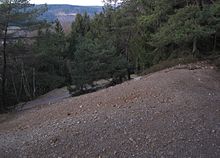Leibnitz mine
| Leibnitz mine | |||
|---|---|---|---|
| General information about the mine | |||
| Letterhead from the mine operator Saturn 1865 | |||
| other names | Leibnitz-Dante | ||
| Information about the mining company | |||
| Start of operation | 1838 | ||
| End of operation | 1869 | ||
| Funded raw materials | |||
| Degradation of | Copper ore | ||
| Geographical location | |||
| Coordinates | 50 ° 55 '42 " N , 7 ° 12' 3" E | ||
|
|||
| Location | Hope valley | ||
| local community | Rösrath | ||
| District ( NUTS3 ) | Rheinisch-Bergischer Kreis | ||
| country | State of North Rhine-Westphalia | ||
| Country | Germany | ||
| District | Bensberg ore district | ||
The Leibnitz mine , sometimes also called Leibnitz-Dante mine , is a former non-ferrous metal ore mine in the Bensberg ore district in Rösrath in the Hopesthal district . The Leibnitz mine field extended in the vicinity of the street Am Heidenkeller in Sülze.
history
The first written reference to the Leibnitz mine can be found in the Zechenbuch of the Lüderich mine dated September 20, 1838. It reports on an earlier mining "on Heidekeller" without further details. The authorization file at the Arnsberg district government begins with a request for advice from Dr. Christian Wöllner dated October 24, 1838. He applied for mining rights for the Heidekeller copper ore vein, which was to be called Cäcilia in the future. The workforce for the exploration work consisted of two men. In a letter dated February 20, 1839, Wöllner informed the mountain jury that there had been an old mine earlier. The newly cleared deep tunnel has now met the corridor operated by the "old people" . He would like to ask for the award again because he needs the copper ores extracted for his vitriol production . Then on August 14, 1839 he was awarded the name Cäcilia. The Quatembergelder amounting to 4 ½ pence for the mine and 1 ½ pence for "moderation" are (the third quarter in a year) due from the quarter Crucis 1839. Since March 15, 1841, no more Quatember money had been paid. The Cäcilia pit was therefore declared “ back into the open ” , that is to say without possession.
Several requests for encouragement in the period from May 1853 to November 29, 1853 led on July 2, 1854 to another award of copper ore with the name Leibnitz to the Rheinische Bergwerkgesellschaft zu Cöln. Since 1857 the operation has been inactive again and was limited to an indefinite period at the request of the mine operator . The mine operator, meanwhile renamed Saturn Rheinischer Bergwerks-Actien-Verein, applied for an extension of the award to lead and zinc ore on August 1 and 29, 1865 . The corresponding award took place on June 10, 1867. Since that time people have also spoken of the “Leibnitz & Dante” mine , without this term ever having an official character. That was probably due to the fact that you were dealing with two corridors lying close to each other, one of which was called Leibnitz and the other Dante. Nothing is known about other mining activities. The name Leibnitz-Dante has been retained by mineral collectors to this day.
Minerals
The dumps of the Leibnitz mine are repeatedly visited by mineral hunters who look for minerals here, especially azurite and olivite . Particularly beautiful specimens found here have been published by collectors on websites.
literature
- Emil Buff: Description of the Deutz mountain district. Bonn 1882.
- Herbert Stahl (editor), Gerhard Geurts , Hans-Dieter Hilden, Herbert Ommer , Siegfried Raimann: Das Erbe des Erzes, Volume 4, Der Lüderich , Bergisch Gladbach 2008, ISBN 3-932326-52-0
Individual evidence
- ^ Herbert Stahl (editor), Gerhard Geurts, Hans-Dieter Hilden, Herbert Ommer, Siegfried Raimann: Das Erbe des Erzes, Volume 4, Der Lüderich , Bergisch Gladbach 2008, ISBN 3-932326-52-0 , p. 113f.
- ↑ Mineralienatlas-Fossilatlas, Minerals of the Leibnitz-Dante Pit Retrieved on December 24, 2017


